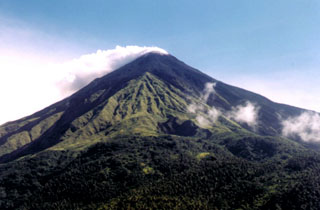Report on Karangetang (Indonesia) — November 2000
Bulletin of the Global Volcanism Network, vol. 25, no. 11 (November 2000)
Managing Editor: Richard Wunderman.
Karangetang (Indonesia) February-December included explosions, ash falls, lava flows, and debris flows
Please cite this report as:
Global Volcanism Program, 2000. Report on Karangetang (Indonesia) (Wunderman, R., ed.). Bulletin of the Global Volcanism Network, 25:11. Smithsonian Institution. https://doi.org/10.5479/si.GVP.BGVN200011-267020
Karangetang
Indonesia
2.781°N, 125.407°E; summit elev. 1797 m
All times are local (unless otherwise noted)
The following report covers activity during February to mid-December 2000. At the beginning of February, the main crater of Karangetang (also known as Api Siau) produced a light-colored ash emission that rose 250-350 m, while Crater II emitted a lighter ash plume to a height of 75-100 m. At night the ash column glowed red to a height of 10-25 m. Similar activity continued through May; variable-density emissions from the main crater rose to a maximum height of 500 m, those from Crater II rose up to 150 m, red illumination was visible up to 75 m at night, and rumbling was heard intermittently through May.
In mid-June tremor events with amplitudes of 0.5-10.5 mm dominated seismicity. Ash plumes continued to rise from both craters, and lava fountaining was observed at the main crater. A lava flow and a debris avalanche sent material up to 300 m from the summit down to the Bahembang River. Red summit illumination was visible at night. Another lava flow and debris avalanche occurred in late June, lava fountains reached 50 m above the summit at times, and the maximum amplitude for tremor was 33 mm in early September. Relatively similar activity persisted through the end of the month.
During mid-October, activity increased significantly. The two craters continued to emit light-colored, variable-density ash plumes, and thundering could be heard. At 1840 on 14 October, observers saw lava flowing 100 m down to the Nenitu River. Lava avalanches traveled up to 1,000 m from the summit. Seismicity increased notably with many A-type earthquakes, tectonic earthquakes, explosive events, and continuous tremor. At 1131 on 27 October, a small explosion sent a dark ash plume to a height of 1 km. An ash cloud drifted E to the sea, while pyroclastic flows burned vegetation along their paths and reached ~1,500 m down the E, W, and S flanks. During this period, multi-phase earthquakes occurred and tremor became discontinuous.
Another explosion at 2030 on 2 November sent dark ash 1.5 km above the summit. Ashfall and pyroclastic flows occurred along the flanks; ash followed a similar pattern of distribution as after the 27 October explosion. Seismicity quieted slightly following this explosion. A smaller explosion occurred on 11 November and dark ash rose 600 m. Ash fell around the summit area, and no injuries were reported. Red illumination at night and frequent booming sounds accompanied ash plumes that continued to rise from the main crater and Crater II during October-November.
Seismicity increased by 12 December with nearly fifteen times as many multi-phase earthquakes as in late November, and the resumption of continuous tremor. Thundering sounds continued to be heard often, and red summit illumination could be observed occasionally at night. The main crater and Crater II emitted a light-colored, variable-density ash plume to 150 m above Karangetang's summit. The volcano maintained a hazard status of 2 (on a 1-4 scale) during the report period.
Geological Summary. Karangetang (Api Siau) volcano lies at the northern end of the island of Siau, about 125 km NNE of the NE-most point of Sulawesi. The stratovolcano contains five summit craters along a N-S line. It is one of Indonesia's most active volcanoes, with more than 40 eruptions recorded since 1675 and many additional small eruptions that were not documented (Neumann van Padang, 1951). Twentieth-century eruptions have included frequent explosive activity sometimes accompanied by pyroclastic flows and lahars. Lava dome growth has occurred in the summit craters; collapse of lava flow fronts have produced pyroclastic flows.
Information Contacts: Dali Ahmad, Volcanological Survey of Indonesia (VSI), Jalan Diponegoro No. 57, Bandung 40122, Indonesia (URL: http://www.vsi.esdm.go.id/).

